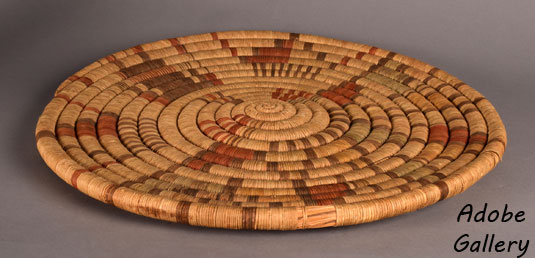Hopi Second Mesa Coiled Basketry Plaque with Katsina Face [SOLD]
+ Add to my watchlist Forward to Friend
- Category: Trays and Plaques
- Origin: Hopi Pueblo, Hopituh Shi-nu-mu
- Medium: yucca, galleta grass, native dyes
- Size:
17-½” diameter;
¾” coil diameter - Item # C4502K SOLD
This is an early Hopi Second Mesa coiled plaque, probably circa 1920s or so. It has the fat coils of the earlier ones and the muted colors too. The image is that of a katsina, but the face is abstract and not easily identified. To get oriented, start with the three thin black lines and the grouping of red below the black. That is the face of the katsina. The group of black and red lines represent the chin or lower face. The large black below is the dress. Note the arms and hands and the feet. Now it is oriented correctly in your mind. It appears that the katsina is wearing a large tablita on its head. This can be seen in the upper half of the weaving.
The foundation of the coils is a bundle of grasses. The weft, or pictorial stitches, are made from the leaves of the yucca plant which were dried and dyed with colors from nature. Traditionally, all the plant materials needed to make the fibers for basket weaving come from wild plants; none of them are domesticated. The major source for Hopi coiled basketry material is the yucca plant, which once grew in greater abundance around the Hopi Mesas than it does today. An intimate knowledge of nature and its products involves a sense of dependence on the cycles of the season. Each plant has its time of collecting during the year, and each time is carefully observed by the basket weaver.” Teiwes 1996:11
“The colors in coiled plaques and baskets are limited to a palette of white, yellow, green, red, and black. But from these five colors Hopi women produce a multitude of colorful and difficult designs. The colors, white, yellow, and green are natural colors that come from yucca leaves. Red (or orange-red) and black materials are dyed yucca leaves. To achieve two of the three natural colors—white and yellow—the yucca leaves have to be collected at specific times of the year. For green, leaves from the outer part of the yucca plant are selected during the entire year.” ibid 11
Condition: good condition with minor stitch loss and minor fading
Provenance: this Hopi Second Mesa Coiled Basketry Plaque with Katsina Face is from the collection of a gentleman from California
Reference: Teiwes, Helga. Hopi Basket Weaving - Artistry in Natural Fibers, University of Arizona Press, Tucson

- Category: Trays and Plaques
- Origin: Hopi Pueblo, Hopituh Shi-nu-mu
- Medium: yucca, galleta grass, native dyes
- Size:
17-½” diameter;
¾” coil diameter - Item # C4502K SOLD



